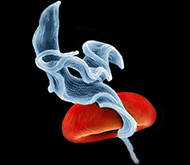Projects
Ribosome biology & translation control
The regulatory non-coding RNA interactome of translating ribosomes
The elusive molecular biology of the vault RNA
Ribosome biology & translation control
For decades, ribosomes, the cellular machines producing proteins encoded in the genome, have been believed to be rather static complexes with a defined structure–function relationship. Nevertheless, during evolution, ribosomes expanded dramatically on the rRNA and r-protein levels. In addition, single nucleotide variants (SNV) in the rRNA genes, differential rRNA modifications, and transiently associated factors (e.g. ribosome-associated ncRNAs) further contribute to the heterogeneity of the translation machinery.
While functionally crucial sites of the ribosome such as the peptidyl transferase center, or the decoding center, remained essentially unaltered during evolution, rRNA structures at the periphery of the particle expanded in size and preferentially accumulated SNV (Fig. 1). In many cases, the biological roles of these ribosome heterogeneities remained elusive.
Our research is based on the hypothesis that rRNA expansion segments (i) either recruit additional factors to the ribosome, or (ii) modulate the structural dynamic and thus the translational landscape of the translation machinery in a stress-dependent manner. We use the budding yeast S. cerevisiae as a model organism which allows selective interrogation of ribosomal expansion segments and SNV. We combine classical molecular biology and biochemistry with modern translatome-wide approaches to quantify gene expression and translation dynamics.
 Fig. 1: E. coli, S. cerevisiae, and H. sapiens large subunit (LSU) rRNA structures were aligned and displayed to proportion based on structures to illustrate the expansion. The expansions are highlighted in cyan for yeast or hot pink for human ribosomes. The extent to which expansion occurred is underestimated in these figures since many of the large ES cannot be resolved in high-resolution structures of the ribosome (taken from Rauscher & Polacek, 2024).
Fig. 1: E. coli, S. cerevisiae, and H. sapiens large subunit (LSU) rRNA structures were aligned and displayed to proportion based on structures to illustrate the expansion. The expansions are highlighted in cyan for yeast or hot pink for human ribosomes. The extent to which expansion occurred is underestimated in these figures since many of the large ES cannot be resolved in high-resolution structures of the ribosome (taken from Rauscher & Polacek, 2024).

